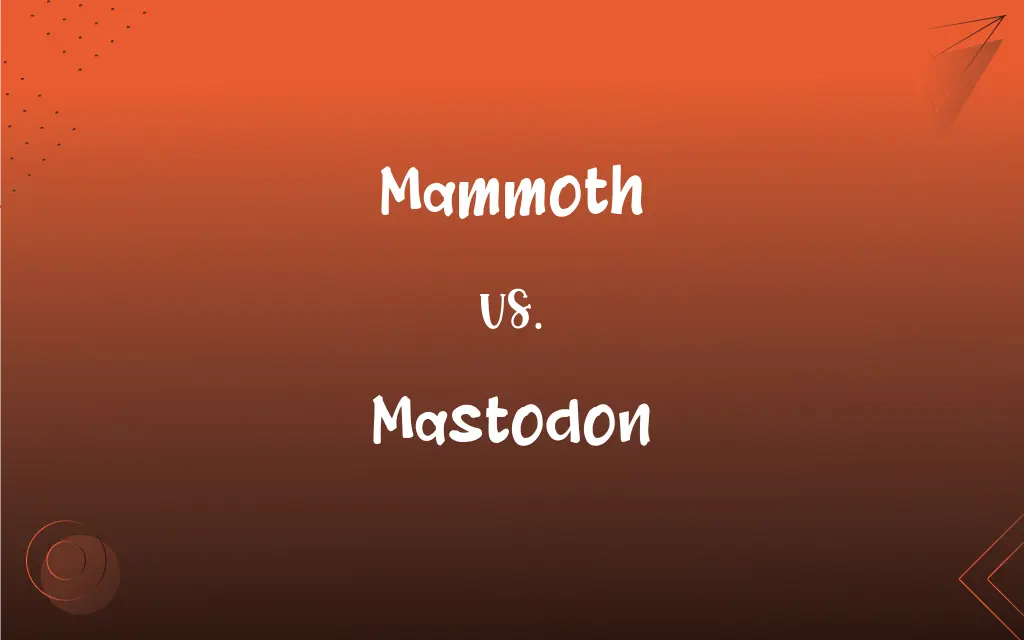Mammoth vs. Mastodon: What's the Difference?
Edited by Harlon Moss || By Janet White || Updated on October 22, 2023
Mammoths are large extinct elephants known for long, curved tusks, while mastodons are prehistoric relatives with straighter, conical tusks.

Key Differences
Mammoths belong to the Elephantidae family and are closely related to modern elephants. In contrast, mastodons belong to the Mammutidae family and have different evolutionary lines.
Mammoths, especially the woolly mammoth, are known for their shaggy fur adapted to cold climates. Mastodons, however, had less fur and preferred forested environments.
When observing their teeth, mammoths had long, flat, and ridged molars suited for grazing on grass. Mastodons, on the other hand, had conical, nipple-like cusps on their molars, tailored for browsing on shrubs and trees.
The iconic curved tusks of mammoths were often more spiraled and elongated, while mastodon tusks were relatively straighter and more robust.
Both these magnificent creatures roamed different parts of the world, with mammoths found mainly in northern parts of North America and Eurasia, whereas mastodons were widespread across North and Central America.
ADVERTISEMENT
Comparison Chart
Family
Elephantidae (Elephant family)
Mammutidae
Appearance
Shaggy fur, long curved tusks
Less fur, straighter tusks
Dietary Adaptations
Long, flat, ridged molars for grass
Cusped molars for shrubs and trees
Habitat
Cold climates like tundras
Forested environments
Geographical Distribution
Primarily northern parts of North America and Eurasia
Widespread in North and Central America
ADVERTISEMENT
Mammoth and Mastodon Definitions
Mammoth
An extinct large elephant with long, curved tusks.
The frozen remains of the mammoth were discovered in Siberia.
Mastodon
An ancient mammal known for its stout build.
The mastodon's skeletal structure hints at its power and strength.
Mammoth
A prehistoric creature known for its adaptation to cold climates.
The mammoth's fur coat protected it from icy conditions.
Mastodon
An extinct relative of elephants with conical-shaped teeth.
The mastodon's remains are often found in North America.
Mammoth
A creature often depicted in prehistoric cave art.
Early humans painted the mammoth on cave walls, showcasing their significance.
Mastodon
A prehistoric mammal with straighter, robust tusks.
Unlike the mammoth, the mastodon had distinctively straight tusks.
Mammoth
A relative of the modern elephant, now extinct.
Archaeologists found mammoth bones alongside ancient human tools.
Mastodon
A creature from the Mammutidae family, different from mammoths.
Mastodons roamed forests, munching on shrubs and trees.
Mammoth
A term describing immense size or magnitude.
The construction project was a mammoth undertaking.
Mastodon
A term occasionally used to describe something massive or ancient.
The library was a mastodon, filled with old and rare books.
Mammoth
Any of various extinct elephants of the genus Mammuthus of the Pliocene, Pleistocene, and Holocene Epochs, having ridged molars and often, as in the woolly mammoth, long tusks and hair.
Mastodon
Any of several very large, extinct proboscidian mammals of the family Mammutidae of the Miocene, Pliocene, and Pleistocene Epochs, resembling elephants but having molar teeth of a different structure.
Mammoth
Something that is of great size.
Mastodon
Extinct elephant-like mammal of the genus †Mammut that flourished worldwide from Miocene through Pleistocene times; differs from elephants and mammoths in the form of the molar teeth.
Mammoth
Of enormous size, extent, or amount; huge.
Mastodon
(figurative) Anything big or clunky.
Mammoth
Of great scope or importance
Mammoth expectations.
Mastodon
An extinct genus of mammals closely allied to the elephant, but having less complex molar teeth, and often a pair of lower, as well as upper, tusks, which are incisor teeth. The species were mostly larger than elephants, and their remains occur in nearly all parts of the world in deposits ranging from Miocene to late Quaternary time.
Mammoth
Any species of the extinct genus Mammuthus, of large, usually hairy, elephant-like mammals with long curved tusks and an inclined back, which became extinct with the last retreat of ice age glaciers during the late Pleistocene period, and are known from fossils, frozen carcasses, and Paleolithic cave paintings found in North America and Eurasia.
Mastodon
Extinct elephant-like mammal that flourished worldwide from Miocene through Pleistocene times; differ from mammoths in the form of the molar teeth
Mammoth
(obsolete) A mastodon.
Mammoth
(figuratively) Something very large of its kind.
Mammoth
Comparable to a mammoth in its size; very large, huge, gigantic.
Mammoth
An extinct, hairy, maned elephant (Mammuthus primigenius formerly Elephas primigenius), of enormous size, remains of which are found in the northern parts of both continents. The last of the race, in Europe, were coeval with prehistoric man.
Mammoth
Resembling the mammoth in size; very large; gigantic; as, a mammoth ox.
Mammoth
Any of numerous extinct elephants widely distributed in the Pleistocene; extremely large with hairy coats and long upcurved tusks
Mammoth
So exceedingly large or extensive as to suggest a giant or mammoth;
A gigantic redwood
Gigantic disappointment
A mammoth ship
A mammoth multinational corporation
FAQs
Are mammoths and mastodons the same?
No, while both are prehistoric, mammoths and mastodons belong to different families and have varying characteristics.
What is a mammoth?
A mammoth is an extinct, large elephant known for its long, curved tusks and adaptation to cold climates.
Where were mammoths primarily found?
Mammoths were primarily found in the northern parts of North America and Eurasia.
Were mastodons as furry as mammoths?
No, mastodons had less fur compared to the shaggy mammoths.
Which creature, mammoth or mastodon, had more curved tusks?
Mammoths had more curved and spiraled tusks than mastodons.
Which creature's remains are more commonly found?
This varies by region, but in North America, mastodon remains are often more common.
Did humans interact with both mammoths and mastodons?
Yes, evidence suggests early humans interacted, hunted, and even depicted both in art.
Which had more complex molars, mammoths or mastodons?
Mammoths had long, flat, ridged molars while mastodons had simpler, nipple-like cusps.
What did mastodons primarily eat?
Mastodons were browsers, feeding on shrubs and trees.
Were mammoths bigger than mastodons?
Size varied by species, but some mammoth species were indeed larger than mastodons.
How does a mastodon differ from an elephant?
A mastodon is an extinct mammal from the Mammutidae family, having straighter tusks and conical molars, distinct from modern elephants.
Which creature, mammoth or mastodon, survived longer?
Mammoths survived longer, with the last populations existing around 4,000 years ago.
Were there different species of mammoths and mastodons?
Yes, multiple species of both mammoths and mastodons existed over time.
Did mammoths and mastodons have any predators?
Besides humans, predators like saber-toothed cats and dire wolves might have preyed on younger or weaker individuals.
Why did mammoths go extinct?
A combination of climate change and overhunting by humans are believed to be major factors.
Were mastodons present during the Ice Age?
Yes, mastodons lived during parts of the Ice Age but were also present before it.
Where can I see a mammoth or mastodon skeleton?
Many natural history museums worldwide display mammoth and mastodon skeletons.
Do we have DNA samples of mammoths and mastodons?
Yes, preserved remains have provided DNA samples for both creatures, especially mammoths.
Can mammoths or mastodons be brought back through cloning?
The idea is debated, but there are significant ethical, technical, and ecological challenges.
Why are mammoths and mastodons important for study?
They offer insights into prehistoric ecosystems, evolution, and human interactions with megafauna.
About Author
Written by
Janet WhiteJanet White has been an esteemed writer and blogger for Difference Wiki. Holding a Master's degree in Science and Medical Journalism from the prestigious Boston University, she has consistently demonstrated her expertise and passion for her field. When she's not immersed in her work, Janet relishes her time exercising, delving into a good book, and cherishing moments with friends and family.
Edited by
Harlon MossHarlon is a seasoned quality moderator and accomplished content writer for Difference Wiki. An alumnus of the prestigious University of California, he earned his degree in Computer Science. Leveraging his academic background, Harlon brings a meticulous and informed perspective to his work, ensuring content accuracy and excellence.

































































